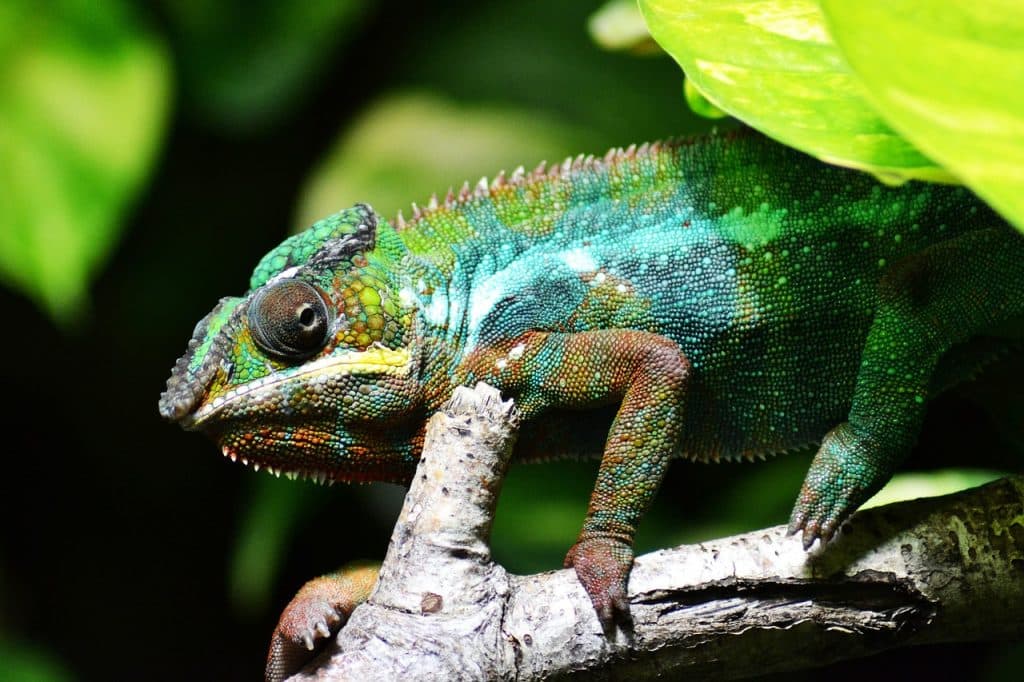
Chameleons can be fascinating creatures and it is an amazing adventure to own one. They are fascinating creatures that do amazing things, but they can also be very low-maintenance making them ideal pets for any animal lover.
First-time owners may not know what to expect because most people have never owned one. This means that you might not be able to tell if your chameleon is growing normally or if they are developing in a way that is unusual.
This chart will give you an idea about the size of four common chameleon species at various life stages. These ranges may not be exact for your lizard, but they are guidelines.
Facts about Chameleons
Chameleons actually belong to the iguana order, which is why they are similar to common lizards. One thing is different about Chameleons: They can alter their skin color.
Contrary to popular belief, chameleons do not change their colors to match their environment. Chameleons can change their colors due to their mood, temperature, and humidity.
They will change the colors they wear depending on their environment and species. Different individuals can sport different colors even within the same species. The color of their skin may be influenced by their personalities. For example, dominant chameleons are more brightly colored than submissive lizards.
There are many species of chameleons. Some species, like the pygmy and Malagasy giant Chameleons, can be quite small while others can reach several feet in length. The majority of commercially available chameleons are less than 2 feet in length, so you don’t have to worry about your home being overtaken by a gigantic, color-changing lizard.
Unfortunately, chameleons have a short lifespan so expect them to live a few more years. Some species can live up to 10 years in captivity. It all depends on what species they are and how well they are cared for.
Chart of Veiled Chameleon Growth and Size
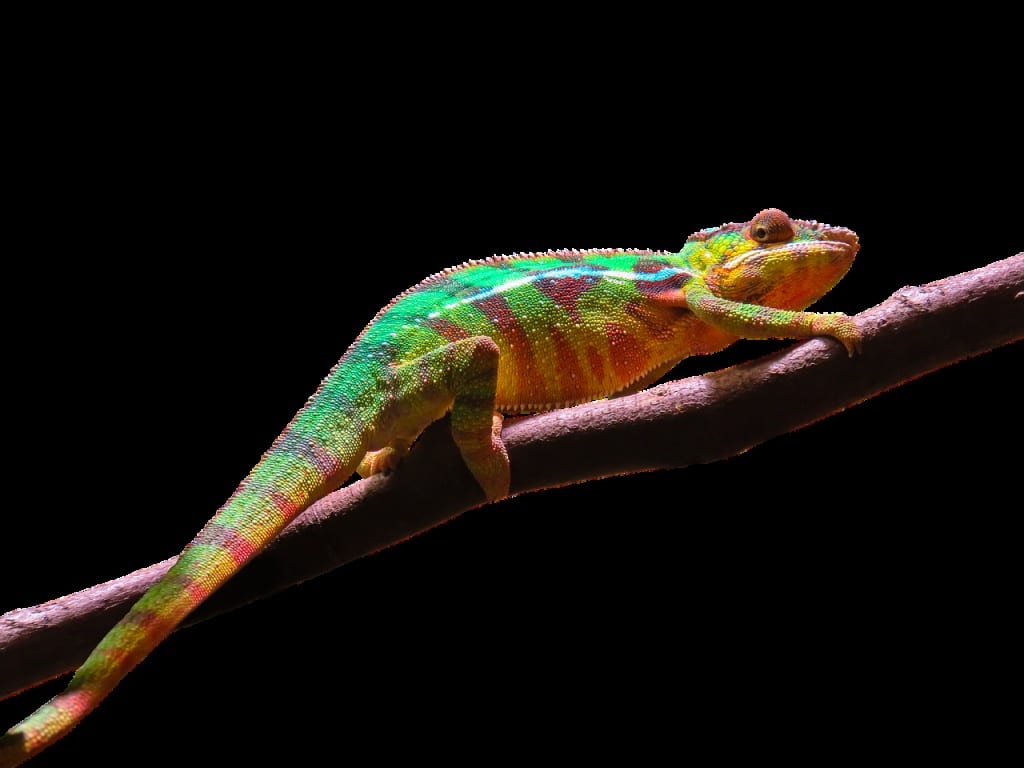
The Veiled Chameleons are the largest species of chameleons, with males often reaching 2 feet in length. This species is well-known for its tall casque, a helmet-like structure on its heads.
| Age | Weight | Body Length |
| Hatchling | Below 1/10th of an ounce | 3-4 Inches |
| 4 weeks | .2-.3 ounces | 4-6 inches |
| 2 months | .7-1.25 ounces | 5-7 inches |
| 3 Months | 1.5 to 2.5 ounces | 8-12 inches |
| 4 Months | 2.75-3.25 ounces | 10-14 inches |
| 6 Months | 4.5-6 ounces | 12-18 inches |
| 9 Months | 6-6-7.75 ounces | 14-20 inches |
| 1 Year | 6.75-9 ounces | 18-24 inches |
Growth Chart for the Panther Chameleon
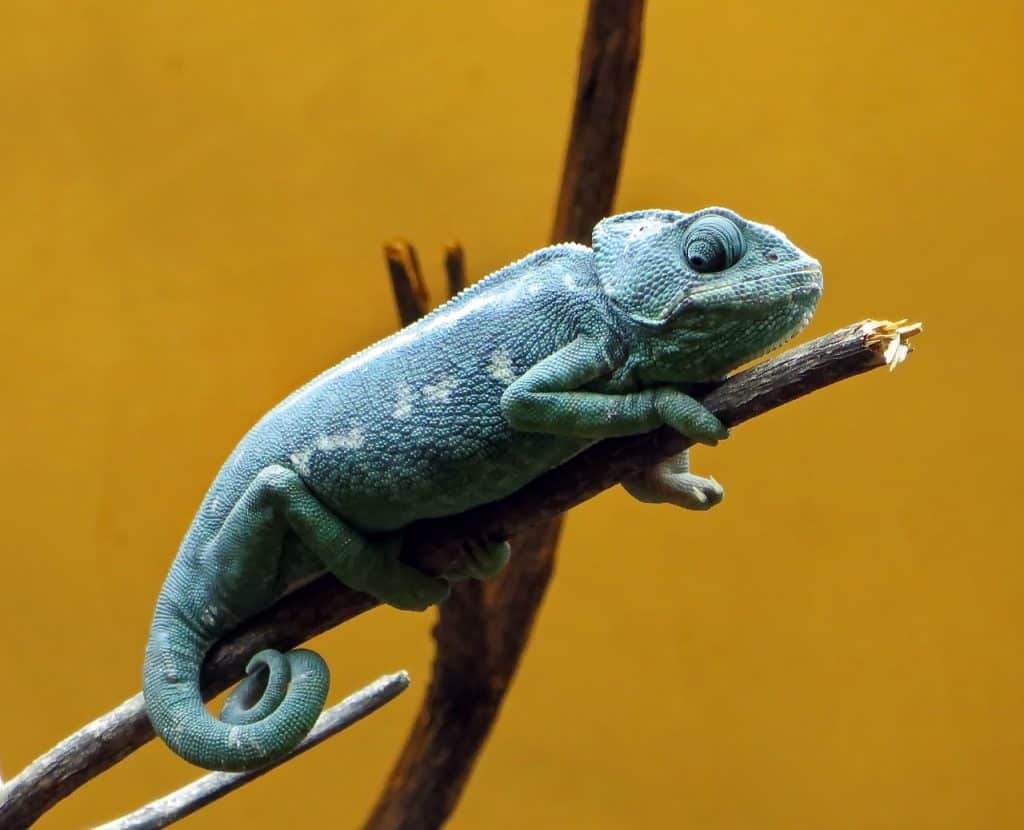
Panther chameleons are much shorter than their veiled counterparts. They can grow up to 6-7 inches in length, but females can grow up to twice that size. Their vibrant colors vary depending on where they live. However, males are more colorful than their female counterparts.
| Age | Weight | Body Length |
| Hatchling | Below 1/10th of an ounce | 2 to 4 inches |
| 4 weeks | .1 to.3 ounces | 2-5 Inches |
| 2 months | 4 to 75 ounces | 4-6 inches |
| 3 Months | .8-1.25 ounces | 5-8 inches |
| 4 Months | 1.5-2.25 ounces | 6-10 Inches |
| 6 Months | 2.75-4 ounces | 8-14 inches |
| 9 Months | 3.25-6 ounces | 8-16 inches |
| 1 Year | 3.5 to 6.5 ounces | 10-18 inches |
Chart of Pygmy Chameleon Growth and Size
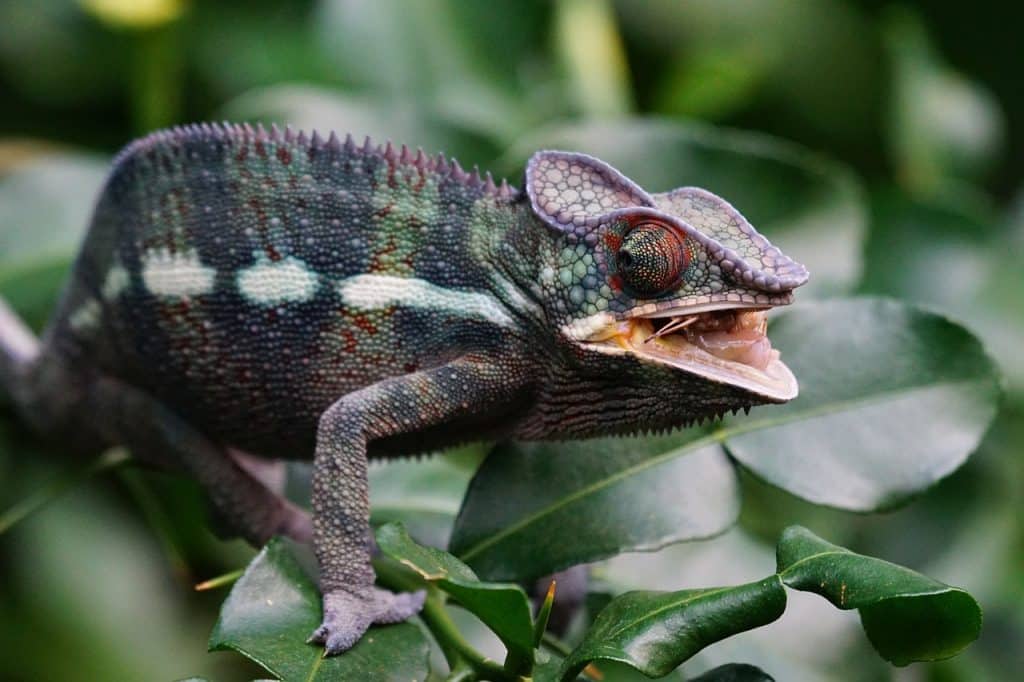
Pygmy Chameleons are small lizards that can fit into your palm. They’re also quite difficult to take care of so only experienced owners should be allowed to handle them. Although they are sweet-natured, owning one can be very rewarding.
| Age | Weight | Body Length |
| Hatchling | Below 1/10th of an ounce | Below 1 inch |
| 4 weeks | .1 to.2 ounces | Below 1 inch |
| 2 months | .1 to.3 ounces | Below 1 inch |
| 3 Months | .2-.4 ounces | 1-1.5 inches |
| 4 Months | .2-.5 ounces | 2 to 3 inches |
| 6 Months | .3 to.6 ounces | 1.5 to 2.5 inches |
| 9 Months | .3 to.7 ounces | 1.5-3 Inches |
| 1 Year | .4 to.7 ounces | 2-3 inches |
Jackson’s Chameleon Size Chart and Growth Chart
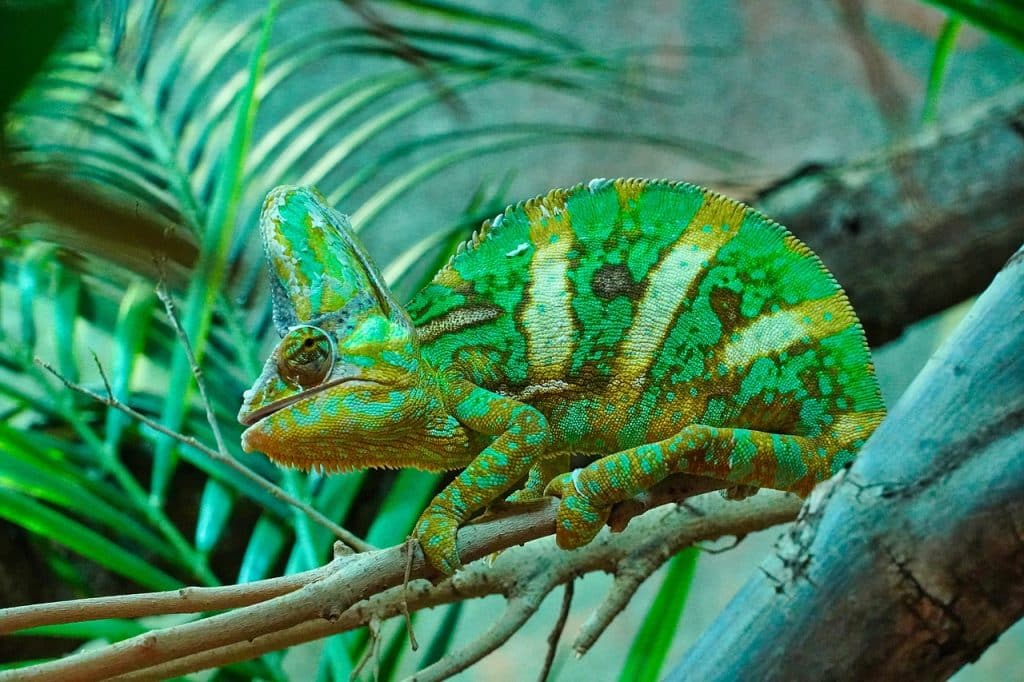
Jackson’s Chameleons are well-known for their three horns on the heads of the males. The females do not have any horns. These lizards are medium-sized and usually bright green. These lizards are also well-known for their hair-trigger color variations.
| Age | Weight | Body Length |
| Hatchling | Below 1/10th of an ounce | 2 to 4 inches |
| 4 weeks | Below 1/10th of an ounce | 2-5 Inches |
| 2 months | .1 to.2 ounces | 3 to 6 inches |
| 3 Months | .1 to.3 ounces | 3-7 inches |
| 4 Months | .2-.4 ounces | 4-8 inches |
| 6 Months | .4 to.7 ounces | 5-10 inches |
| 9 Months | .6-1 ounce | 6-12 inches |
| 1 Year | .8-1.25 ounces | 6-15 Inches |
When do Chameleons stop growing?
The exact species of chameleon that is affected will determine when they stop growing, but generally, they should have reached full maturity by 18 months. Many chameleons stop growing at 9 to 12 months of age.
Chameleons will generally stop growing longer at 8 months of age, but they will continue to gain weight until 2 years of age.
Is Chameleon Growth Influenced by the Size of the Cage?
Although a small cage should not hinder chameleon growth, it can indicate that the lizard has been neglected. This will affect their size.
Their diet and their stress levels are the main factors that determine a chameleon’s size. Even if they are eating a healthy diet, placing them in a small cage can make them feel anxious and stressed. They may not be able to reach their full potential and their life expectancy can be reduced by this stress.
They don’t need large cages so it shouldn’t be difficult to provide them with all they need.
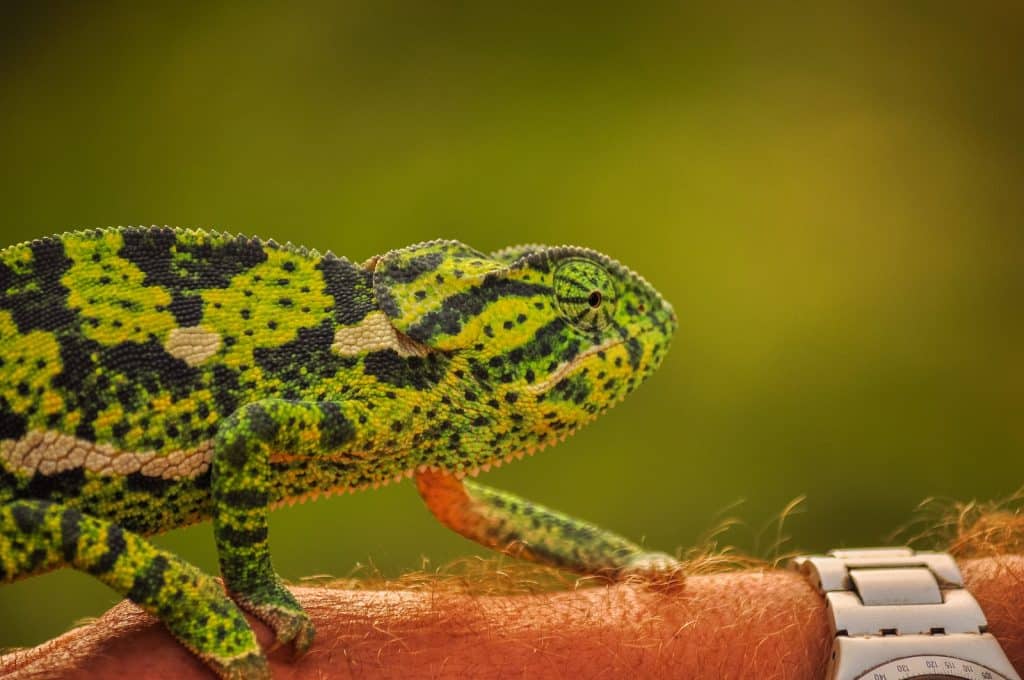
The Ideal Chameleon Diet for Optimal Growth
Chameleons can eat both insects and plants. However, it’s not enough to just throw a few bugs and some vegetables in their tank.
You should give them as many different types of insects as you can. They love mealworms and waxworms.
It is a good idea to feed them gut-loaded insects. These bugs should have been fed recently, with foods rich in nutrients that cater to chameleons. It is possible to dust them with vitamin and calcium supplements.
Chameleons love dark leafy greens such as ficus and collard greens. To prevent them from rotting, wash them first.
Conclusion
Although owning a chameleon is a rewarding and fun experience, it can also be stressful if you aren’t sure what to expect. This growth chart will help you to see where your chameleon will be at different stages of its development.
There are many variations within each individual animal. Don’t panic if your chameleon doesn’t fit into the above criteria. Keep an eye on your chameleon and look out for signs of trouble.
Can chameleons be kept as pets?
They make excellent pets for a variety of reasons. One evident difference is that they are little. That implies you don’t need a lot of space to store them. Chameleons are also quiet, colorful, and simple to care for if you have some experience.
Can two chameleons be kept in the same tank?
The reality is that you should never keep two or more chameleons together. It’s natural to believe that your pet would be uncomfortable living alone in the terrarium, yet chameleons have repeatedly proved that they enjoy living alone.
Do chameleons require constant light?
Chameleons will suffer from major health issues if UVB illumination is not provided (MBD). UVB lighting should be turned on for 10-12 hours each day and off at night.
So, can a chameleon identify its owner?
Yes! In as little as one week, a chameleon may know its owner. This is very dependent on a variety of circumstances, including the chameleon’s species and sex, your ability to build attachments with it quickly, and the sort of care you provide.
Chameleons and frogs may coexist.
It is best to keep your chameleons and tree frogs in different enclosures?
Chameleons are happiest — if that’s a word — and thrive best when housed alone.
Chameleons are poisonous?
Appearance. Chameleons often seem green or brown in order to blend into their arboreal home. This natural color shields them from predators. It keeps them safe since they lack poison or a lethal bite to protect themselves.
Can a chameleon bite cause pain?
Chameleons are solitary creatures. Forced or unwanted handling might result in hissing and biting. The bite of a chameleon is unpleasant, although it is not poisonous or hazardous to people.
Do chameleons defecate and pee?
Chameleons, like certain other animals, produce urea in solid form and dump it out as a solid white lump rather than removing liquid waste in the form of urine as we do. Chameleons pass urate rather than urine in order to retain more water for hydration.
Chameleons do they have teeth?
Chameleon teeth are acrodont (Fig. 6.78) and are not replaced. On the palate, there are no teeth. The premaxilla is smaller and can only support two little teeth, whereas the maxilla and dentary normally support 15 to 22 teeth (Edmund, 1969).
Chameleons are they friendly?
They dislike social engagement and prefer to remain alone. However, there are a few chameleon species that don’t mind perching on people for a few minutes.